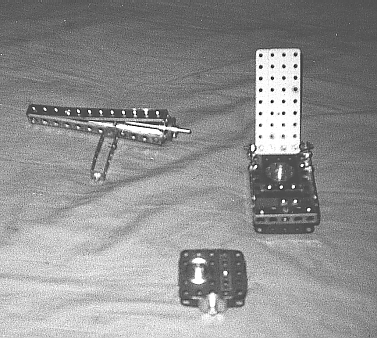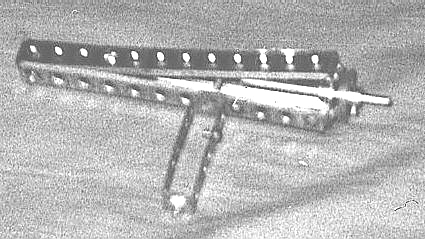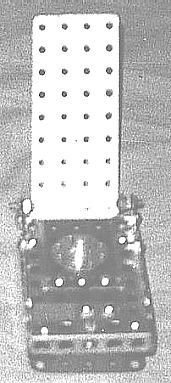I was a Teenage Prop Freak
or
To Irving, With Love

By Ted Eckel
whose phaser is always set on stun
I didn't catch Star Trek until it was in syndication in the early 70's -- I was around
8 years old or so, and the series immediately caught my imagination. After joining Kirk
and Spock for a season's tour of the galaxy, I was hooked. I couldn't get enough Star
Trek. Of course, this was long before VCRs were a common household word, so I had to be
content with the network's syndication schedule. I also had to be content with the scant
Trek merchandise of the time.
My first find was the model of the Enterprise. This one was the deluxe baby with real
working lights. I was in heaven. But what I REALLY wished for was a set of official Star
Trek landing party gear -- phaser, communicator and tricorder. However, all that was
available at the time was a generic disc shooting gun that looked nothing like the phasers
Kirk used, but this didn't stop the manufacturer from slapping a picture of Kirk and Spock
on the package and calling the toy a Star Trek Tracer Gun. So, I did what any kid
would do, I made my own.
 I probably made about a dozen phasers and communicators over the next few years.
These were not works of art but rather works of love assembled from spare Legos,
Erector set parts, pencil boxes and whatever else I could find in the family's
junk drawer. They were enough to get me and a friend through countless imagined
Star Trek adventures.
I probably made about a dozen phasers and communicators over the next few years.
These were not works of art but rather works of love assembled from spare Legos,
Erector set parts, pencil boxes and whatever else I could find in the family's
junk drawer. They were enough to get me and a friend through countless imagined
Star Trek adventures.
As the years went by, my interest in Star Trek continued, as did my fascination with
the gadgetry used on the show. I recall being very frustrated because I could never make
out all the fine details on the various Trek hand props (I guess I was anal retentive even
way back then). Close-up scenes of the props were few and far between, and again, this was
before VCRs and "pause" buttons. Adding to my confusion over the prop details
was the fact that many of the props went through physical changes throughout the three
seasons of the series. Imagine my delight when I stumbled across my first copy of
"The Making of Star Trek" and found page after page of close-up photos of many
of the Star Trek props. Now I could see that the communicator had a moiré pattern and
rhinestone buttons.
.
The various control knobs on the phaser were no longer a mystery. At long last I could
see the various doo-dads that McCoy used to save lives. And finally I could see what was
inside the tricorder's middle compartment. Now that I had uncovered all the hidden prop
details, I wanted them more than ever. And sadly, now that I knew exactly what they should
look like, my homemade creations weren't as appealing. The good news was that more Trek
toy communicators and phasers were being made. The bad news was that they all were grossly
inaccurate.
Why did MEGO have to make their communicator walkie-talkies BLUE? And why didn't they
put holes in the flip grid? Didn't they have a copy of "Making of Star Trek"
like I did? I also recall a phaser toy that, while close to the proper size, did not
resemble the actual prop -- especially with that goofy oversized flashlight nozzle tip.
So, I decided that the only way to get props like the ones used in the show was to get the
ones actually used in the show. They must have a few to spare, I thought, after all, Kirk
and his crew were always tossing them about, so there must be at least fifty or so just
sitting around the studio filming lot. So I wrote a letter to Irving Feinberg at Paramount
Pictures.
Mr. Feinberg was listed in the Star Trek credits as Property Master, and I thought a
pleasant letter expressing my enthusiasm for the show and a request for a communicator and
phaser would do the trick. Of course, the show had long since been canceled, but a 12 year
old doesn't understand syndication, so I thought Irving was still carting around trunk
loads of phasers and communicators. Somehow or other, the letter ended up on the desk of
someone at Paramount with a similar last name, and this person was nice enough to send me
a reply. He explained that Star Trek was no longer being made, and that what few props
were left over were given to the actors who were in the show. He was nice enough to send
me an 8x10 photo of the communicator, which I noted was the same one used in the
"Making of Star Trek."
So, it was back to my homemade creations.
When I was young, there were kids that played cops and robbers. Or cowboys and Indians.
Or baseball and football. And then there were a few odd kids like me that played Captain
Kirk and Mister Spock.
With little more than a few shoe boxes, some Legos and odds and ends from Dad's junk
drawer, my friend and I would create the futuristic computer panels for our makeshift
Bridge from which I would command my pretend starship Enterprise. My official Starfleet
uniform was no more than an old pajama top with an aluminum foil emblem Scotch-taped
across the pocket. We would beam down to strange planets, all of which, coincidentally,
looked like my back yard. A squirt gun spray-painted silver served as my trusty phaser gun
(to fend off any nasty Klingons).
But the crudeness of our props never stopped us from saving the universe. \ Now it's
some 20 years later, and while my homemade Star Trek equipment hasn't survived, the
Star Trek show has lived on in syndication, through several theatrical movies, a new
TV series "Star Trek: The Next Generation (TNG)" and two spin-off series,
"Star Trek Deep Space Nine," and "Star Trek Voyager." Over this time,
toy companies have discovered the Trek empire to be a very fruitful business.
Galoob Toys made the first attempt to cash in on the new Star Trek with a line of toy
figures and accessories. While considered coveted collectibles, the line wasn't a huge
commercial success. Then, after He-Man and Teenage Mutant Ninja Turtles toys proved to be
a big hit, a company called Playmates Toys gave the Star Trek franchise another shot,
unveiling a line of figures and role-playing toys that are some of the best ever offered.
What makes Playmates Trek line so exceptional is the attention to detail. Their
sculptors have made an effort to ensure the figurines resemble the actual Enterprise crew
-- even the tiny accessories are accurate to those used in the TV series. To entice the
collectors' market, each figure is stamped with a special number, and many include a
limited edition collectors card or space-cap (the 24th century version of a POG).
If you wish to examine their latest offerings via cyberspace, check out Playmates Toys'
WEB page at: http://www.playmatestoys.com.
You can walk into most any K-Mart, Target or Wal-Mart and find the entire Trek cast
hanging from the toy shelves as 5-inch action figures -- Captain Picard, Klingon Worf,
even the emotionless android Data. There are also talking figures and larger Barbie-doll
size versions.
In addition to the figures, Playmates offers Star Trek playsets, shuttlecrafts and a
complete line of starships with authentic lights and sounds. My favorites are the
full-size phaser and communicator toys, authentically styled after those used by the Star
Trek crew. They've even released a Classic Star Trek Tricorder, the little black box that
Mr. Spock carried around to analyze alien plant life, or that Dr. McCoy put to such
judicious use when diagnosing a red-shirted crewman who had fallen prey to some horrible
alien attack ("He's dead, Jim.").
Of course, Playmates isn't the only company cashing in on the Star Trek craze. Hallmark
has a line of Star Trek ornaments. Franklin Mint offers a variety of Trek collectibles
fashioned in pewter. Another company offers Trek collector's plates. Even the home
shopping channels have special shows dedicated to Trek memorabilia.
But perhaps the best Star Trek toy to hit the 20th century is a real working Tricorder.
A Canadian corporation called Vital Technologies (VT) has found a way to package its
scientific equipment into a device styled after the Tricorder props seen in Star Trek TNG.
And while Vital's Tricorder won't detect Romulans or Dilithium Crystals, it is a precision
environmental monitor with a variety of real-life functional capabilities.
For instance, you can use your VT Tricorder to predict the weather, thanks to its
atmospheric temperature and barometric pressure sensors. Identify electromagnetic fields
with the Tricorder's EMF reader. Flip a switch to activate the Colorimeter, handy for any
color analyzing situation. Need to know light intensity in a pinch? Just activate the
built-in light meter. And, if you need to calculate how old your dog is in light years,
activate the Stardate Clock and Timer. And if that isn't enough, you can plug your VT
Tricorder into any IBM-compatible computer and reprogram it to your specifications.
The Vital Technologies functional Tricorder can be yours by calling 1-800-263-0096. The
call is toll-free, but the VT Tricorder will set you back about $300. to$500. As much as
I'd love one, at that price I'll have to build my own. Now where did I put those Legos?
And while my craftsmanship improved over the years, I discovered I had a lot to learn
after attending my first Star Trek convention. There I was, strutting through a convention
hall somewhere in Detroit, proudly wearing the gold uniform shirt Mom had made for me, my
trusty homemade phaser velcroed to my belt. As I made my way through the dealers room my
head started spinning at all the cool Star Trek stuff for sale. Posters, photos, patches
and tribbles abound. But then I saw the Holy Grail -- a fan-made phaser. This wasn't like
the phaser I had fashioned from cardboard and a garden hose nozzle, this was a museum
quality piece. Hand tooled from aluminum, this phaser looked like the genuine article and
it had a powerful strobe light built into the tip, to boot. My eyes bugged out of my head.
The man who made it allowed me to hold it a little while. When I asked him how much it
was, he informed me that it wasn't for sale, but that it had cost him about $100. Of
course, when you're 12 years old, $100 might as well be $100,000. I thanked him for
letting me hold it and ran off to get James Doohan's autograph. During the entire drive
back to my home in Toledo, you can imagine what I was dreaming of.
As the years went on, my interest in Star Trek and science fiction continued, but my
obsession with props took a back seat to the other things that fill a young boy's life. My
interest in Trek props was rekindled when I heard that AMT was going to release a Star
Trek Exploration Set, released I was disappointed with AMT's lack of attention to detail
and the fact that the pieces were smaller than half-scale size. It wasn't until High
School that I remember the prop bug bit again, as I ordered a communicator from New Eye
Studio. This was not a toy, but rather a fan-made kit made from quality plastic and
machined metal parts -- it was a dream come true. Finally I had something that truly
resembled that actual props used in series.
I am now 34 years old, and have since collected several prop recreations of all my Star
Trek favorites. The pieces I cherish the most are not commercially available, but offered
from a small handful of artists (like Richard Coyle) with an eye for craftsmanship and
detail. I also collect many of the prop toys that have hit the market these past several
years. Playmates released notable toys of the classic Star Trek phaser and communicator --
toys that I would have died to have when I was 8 years old!
In fact, I find it rather ironic that now, some 20 years later, there are nicely done
toys of phasers, tricorders and even McCoy's medical instruments. Playmates has even
announced the future release of Captain Pike's phaser as seen in the first Star Trek
pilot, and if the box art is any indication, this promises to be another nicely done toy.
Despite Playmates attention to detail, their props (or role-playing toys as they like
to call them), sometimes leave a little to be desired. Their classic Trek Tricorder is one
such example. Although accurately styled after the actual prop used in the TV series, the
toy is, unfortunately, nearly half the size it should be. And the Motion Picture Wrist
Communicator was about two times too big. However, I suppose I must forgive Playmates this
occasional blunder, for 90% of their Star Trek merchandise is well crafted with good
attention to details. And I am sure that they are well aware of the inaccuracies in size
of their role-playing toys, and are simply creating what they feel will appeal to both
kids and collectors alike. And, compared to the sometimes hefty prices of "fan
made" prop recreations, Playmates offers an affordable alternative to the less
finicky prop collector.
Also of note is the classic phaser from Franklin Mint. Although it is made out of pewter,
I ordered one of these anyway because it did look nice in their catalog. However, when I
received it, I was disappointed. Somehow the rich look of the piece as it was featured in
the catalog got lost when I pulled it from the box. It looked gaudy and shabbily made.
The nozzle tip was glued on crooked and the back hand-phaser lock bar fell out. The
indicator dial could turn, but soon got stuck as the silver sticker "force setting
indicator" came loose and became lodged inside the clear dial. This was really a
missed opportunity for Franklin. Why they didn't make the piece in authentic colors is
beyond me -- or at least they could have kept the nozzle silver, and not gold. Even more
puzzling is how they expect anyone to accept such poor craftsmanship for $200. I sadly
sent the piece back for a full refund. Maybe mine was a lemon, but I imagine there is a
good chance that all of their phasers feature similar flaws.
So there you have it -- one fan's reminiscing over his obsession with the gadgets that
helped make Star Trek one of today's most popular icons. And Irving, if you happen to read
this, don't forget to save me one of those spare phasers I'm sure you have hidden away in
your attic.









